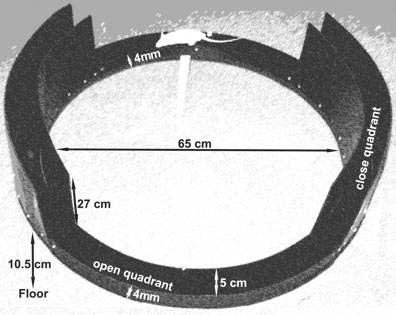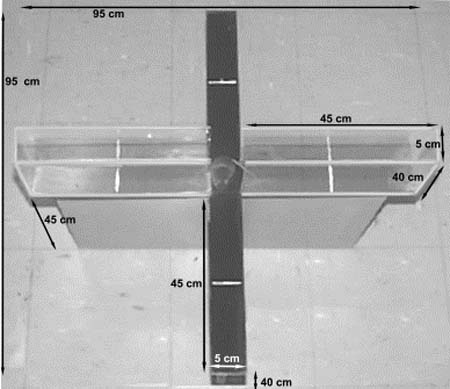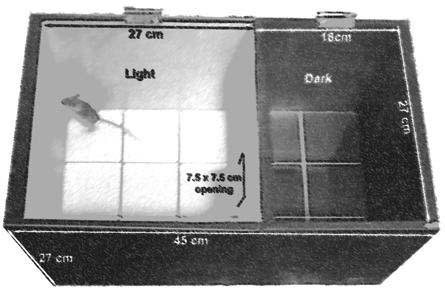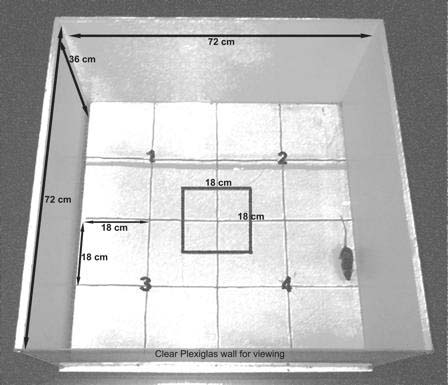Brown1 project protocol
Anxiety, exploratory behavior, and motor activity in 14 inbred strains of mice (2004)
Brown RE, Gunn RK, Schellinck HM, Wong AA, O'Leary TPProject protocol — Contents
Definitions
Workflow, sampling, and experimental treatment
Equipment common to multiple procedures
Notes for all procedures in this project
Procedure: Elevated Zero Maze (EZM)
Procedure: Elevated Plus Maze (EPM)
Procedure: Light – Dark Box (L-D)
Procedure: Open Field Test (OFT)
Data
ReferencesWorkflow, sampling, and experimental treatment
The majority, but not all mice were tested for all procedures. Mice were not pretreated with drugs, special diet, or exposed to other environmental test conditions.
Equipment common to multiple procedures
- Camera-based computer tracking system: (Limelight, Actimetrics; IBM PC computer) fixed to the ceiling 2.1 m above the apparatus for counting line crosses.
- Video camcorder: (Hitachi, VM-7500LA) located 150 cm above the apparatus for recording trials for subsequent analysis (with Hindsight).
- Hindsight event recording software: (MS-dos, version 1.5, Scott Weiss) for scoring behavior.
Notes for all procedures in this project
- Mice are transported to the test room in their home cage. The same test room is used for conducting the elevated zero maze, elevated plus maze, light-dark box, and open field test.
- Mice are handled by the base of the tail or within a 500 mL plastic container when moving into and out of the apparatus.
- Mice are tested in the dark cycle using a 60-watt red light bulb.
- An observer records the behavior of each mouse from a distance of 1 m.
- Each trial is recorded with a video camera positioned above the apparatus (for subsequent computer analysis).
- A camera-based computer tracking system counts line crosses.
- After each test, the numbers of fecal boli and urination puddles are recorded.
- The apparatus is thoroughly cleaned with 70% EtOH and allowed to dry between tests.
---------------------------
Elevated Zero Maze (EZM)
Purpose: To measure anxiety, exploration and motor activity in mice by taking advantage of the innate tendency of mice to avoid open and elevated areas.
Equipment
Elevated Zero Maze: The elevated zero maze was based on the design for rats used by Shepard et al., (1994), and was reduced in size for mice. The maze was made of black Plexiglas and consisted of a 5 cm wide circular pathway that was elevated 10.5 cm above the floor by four wooden legs. The inside of the maze was 65 cm in diameter. The circular pathway was divided into four quadrants, two of which had walls (27 cm high) around the edge (closed quadrants), while the other two did not have walls (open quadrants). A small lip (4 mm) was placed on the edge of the open quadrants to prevent mice from falling off the maze. White lines were drawn every 25 cm along the floor of the maze, and were used to measure motor activity.

Figure 1 illustrates the layout of the elevated zero maze apparatus.
A video camcorder was used to record trials for subsequent analysis. The Hindsight software was used for scoring behavior. For additional information about these components see equipment above.
Environmental test conditions
The apparatus was located in a 1.8 x 4.6 m laboratory room illuminated with a 60-watt red light bulb. Tests were done in the dark phase of the light:dark cycle.
Procedure
- See details common to all procedures in this project.
- Mice are placed in one of the closed quadrants at the start of each trial.
- Mice are allowed to explore the apparatus for 5 min while an observer scored behavior, and a video camera recorded trials for later analysis.
Data collected by investigator
Line crosses, rears, head dips, grooming, stretch attend postures, urination puddles, fecal boli, closed-quadrant entries and duration, open-quadrant entries and duration.
Definitions and calculations
Proportions are based on total arm entries or the duration of the test (5 min).
Total locomotor activity = (line crossing + rearing).
Investigator's notes: The Elevated Zero Maze was originally designed by Shepard et al., (1994), based on the design of the Elevated Plus Maze, in that it is elevated and contains closed regions with walls, and open regions without walls. In both of the elevated mazes mice show a natural avoidance of the open elevated regions (Lister, 1987; Shepard et al., 1994). However, the elevated zero maze holds several advantages over the elevated plus maze in that it (1) has no center square which can produce ambiguous measures and (2) it has a circular design that allows for uninterrupted exploration (Shepard et al., 1994).
Locomotion was measured with the total number of line crosses. Exploratory behaviors include open quadrant activity and head dipping, with a greater number of these measures indicating a greater level of exploration (Shepard et al., 1994; Brown et al., 1999). Fear motivated behaviors include closed quadrant activity, stretch attends, freezing, and a greater number of these measures suggest an increased level of emotionality or fear (Shepard et al., 1994; Lister, 1990). Decreased open quadrant activities and increased risk assessment behaviors (stretch attend postures and head dips) without concomitant changes in general locomotion and exploration indicate increased anxiety in the Elevated Zero-Maze (Shepard et al., 1994). Espejo (1997) describes grooming behavior as a displacement response in the Elevated Plus Maze, which may also apply to the Elevated Zero Maze. Hall (1934) describes defecation and urination to be an index of anxiety in rodents. However, Bindra and Thompson (1953) argue that there is no significant relation between fearfulness and urination and defecation as measured in the Open Field Test. Nevertheless, Bindra and Thompson (1953) agree that defecation and urination in a novel environment is a sign of emotionality, which is not to be equated with fearfulness or timidity.
Repeated testing in the Elevated Zero Maze has been found to increase anxiety related behavior in mice (Cook et al., 2002). Vision also influences behavior on the elevated zero maze, as mice with retinal degeneration show decreased anxiety related behaviors than mice with normal vision (Cook et al., 2001).
----------------------------------
Elevated Plus Maze (EPM)Purpose: To measure anxiety, exploration and activity levels in mice by taking advantage of the innate tendency of mice to avoid open and elevated areas.
Equipment
Elevated Plus Maze: The elevated plus maze was built according to the description of Lister (1987). This maze was made of Plexiglas, and consisted of a central square (5 x 5 cm), from which radiated four arms (5 x 45 cm). Two of the arms had clear Plexiglas walls (15 cm high) around the edge (closed arms), whereas the other two arms did not have walls (open arms). A 0.25 cm high edge was placed around the open arms to prevent mice from falling from the maze. A white line was drawn half way (22.5 cm) along each of the four arms to measure motor activity. The maze was elevated 45 cm above the floor on a plus-shape plywood stand.

Figure 2 shows the layout of the elevated plus maze apparatus.
A video camcorder was used to record trials for subsequent analysis. The Hindsight software was used for scoring behavior. A camera-based computer tracking system was fixed to the ceiling 2.1 m above the apparatus to measure entries and duration in the center, open and closed zones. For additional information about these components see equipment above.
Environmental test conditions
The apparatus was located in a 1.8 x 4.6 m laboratory room illuminated with a 60-watt red light bulb. Tests were done in the dark phase of the light:dark cycle.
Procedure
- See details common to all procedures in this project.
- Mice are placed in the central square of the apparatus, facing an open arm.
- Mice are allowed to explore the apparatus for 5 min while an observer, a video camera, and the automated tracking system record their actions.
Data collected by investigator
Line crosses, rears, head dips, grooming, stretch attend postures, urination puddles, fecal boli, closed-arm entries and duration, open-arm entries and duration, center entries and duration.
Definitions and calculations
Proportions are based on total arm entries or the duration of the test (5 min).
The index of open arm avoidance (Trullas and Skolnick, 1993) is calculated as follows:
Index of open arm avoidance = 100 – [(% time on open arms + % entries onto the open arms)/2]
Total locomotor activity = (line crossing + rearing).
Investigator's notes: Exploratory behaviors include open arm activity and head dipping. A greater number of events indicate a greater level of exploration (Brown et al, 1999). Mice appear unwilling to venture onto the open arms of the maze because of a general aversion to open spaces and to the elevation of the maze (Lister, 1990). Anxiety related behaviors include closed arm activity, grooming, freezing, defecation and urination. A greater number of these events imply a greater level of anxiety or fear (Lister, 1990). Risk assessment behavior (stretch attend postures) is an index of a greater level of anxiety (Blanchard et al., 2001). Decreased open arm activities and increased risk assessment behaviors (stretch attend postures and head dips) without concomitant changes in general locomotion and exploration indicate increased anxiety in the Elevated Plus Maze (Cole and Rodgers, 1994; Lee and Rodgers, 1991). The index of open arm avoidance also gives a measure of anxiety (Trullas and Skolnick, 1993
Grooming behavior displayed in the Elevated Plus Maze is considered to be a displacement response (Espejo, 1997). Hall (1934) describes defecation and urination to be an index of anxiety in rodents. However, Bindra and Thompson (1953) argue that there is no significant relation between fearfulness and urination and defecation as measured in the Open Field test. Nevertheless, Bindra and Thompson (1953) agree that defecation and urination in a novel environment is a sign of emotionality, which is not to be equated with fearfulness or timidity.
Repeated testing on the Elevated Plus Maze has resulted in contradictory findings. Some laboratories have found that behavior is stable over repeated tests (Lister, 1987) whereas others have found that upon repeated testing, the animals display reduced open arm activity, indicating a greater level of anxiety with subsequent tests (Espejo, 1997).
--------------------------------------
Purpose: To measure anxiety and activity levels of mice by taking advantage of the innate tendency of mice to avoid lighted areas in the Light-dark box.
Equipment
Light–Dark box: The light-dark box (45 x 27 x 27 cm) was made of plywood and consists of two chambers that were different sizes and colors. The small chamber (18 x 27 cm) was painted black and the larger chamber (27 x 27 cm) was painted white. An opening (7.5 x 7.5 cm) was located in the wall between the two chambers. Lines were drawn on the floor of the maze and divided the white chamber into nine 9 x 9 cm squares and the dark chamber into six squares. Clear Plexiglas was placed over the floor, and both chambers were covered with lids of Plexiglas. Bright illumination was provided by a 60-watt table lamp located 40 cm above the center of the white chamber.

Figure 3 illustrates the layout of the light-dark box.
A video camcorder was used to record trials for subsequent analysis. The Hindsight software was used for scoring behavior. For additional information about these components see equipment above.
Environmental test conditions
The apparatus was located in a 1.8 x 4.6 m laboratory room illuminated with a 60-watt red light bulb. Tests were done in the dark phase of the light:dark cycle.
Procedure
- See details common to all procedures in this project.
- Mice are placed in the center of the white chamber facing the opening.
- Mice are allowed to explore the apparatus for 5 min while an observer records behavior, and a video camera recorded trials for later analysis.
Data collected by investigator
Line crosses, rears, stretch attend postures, grooming duration, dark zone duration, light-dark transitions, light zone duration, defecation, and urination.
Definitions and calculations
Total locomotor activity = (line crossing + rearing).
Proportions are based on duration of the test (5 min).
Investigator's notes: Mice show an innate preference for the small dark chamber over the larger bright chamber of the light-dark box (Bourin and Hascoet, 2003). Increased time spent in the dark zone and an increased number of stretch attend postures indicates a higher level of anxiety in this test. Locomotor activity can also be assessed in the light-dark box with the number of line crosses and rears.
-----------------------------
Purpose: To measure anxiety, exploration and activity levels of mice, by taking advantage of the innate tendency of mice to avoid open spaces when exposed to an open field arena.
Equipment & software
Open field apparatus: The open field was constructed from plywood (painted white) and measured 72 x 72 cm, with 36 cm high walls. One of the walls was made of clear Plexiglas so that mice were visible within the maze. Blue lines were drawn on the floor, and the lines were visible through the clear Plexiglas floor. The lines divided the floor into 16 18 x 18 cm squares, and these lines were used to measure motor activity. A central square was drawn in the middle of the open field and was used to measure exploration (Brown et al., 1999). The central square is used because some mouse strains have high locomotor activity and cross the lines of the test chamber many times during a test session. The central square has sufficient space surrounding it to give meaning to the central location as being distinct from the outer locations (Carrey et al., 2000).

Figure 4 shows the layout of the open field apparatus. Numbers 1 to 4 depict the limits of the four corner squares.
A video camcorder was used to record trials for subsequent analysis. The Hindsight software was used to score behavior. A camera-based computer tracking system was fixed to the ceiling 2.1 m above the apparatus and was used to measure line crosses. For additional information about these components see equipment above.
Environmental test conditions
The apparatus was located in a 1.8 x 4.6 m test room illuminated with a 60-watt red light bulb. Tests were done in the dark phase of the light:dark cycle.
Procedure
- See details common to all procedures in this project.
- Mice are placed in one of the four-corner squares of the open field apparatus.
- Mice are allowed to explore the apparatus for 5 min while an observer, a video camera, and the automated tracking system record their actions.
Data collected by investigator
For days 1 and 2: line crosses, rearing, grooming, freezing, stretch attend postures, urination puddles, fecal boli, center square entries, center square duration.
Definitions and calculations
Total locomotor activity = (line crossing + rearing).
Investigator's notes: The Open Field Test (Walsh and Cummins, 1976) provides simultaneous measures of locomotion, exploration, and anxiety. The number of line crosses and the frequency of rearing are used as measures of locomotor activity and a high frequency of these behaviors indicates increased locomotion. The number of central square entries and the duration of time spent in the central square are measures of exploration and anxiety (Podhorna and Brown, 2002). A high frequency/duration of these behaviors indicates high exploratory behavior and low anxiety levels. The number of central square entries and the duration of time spent in the central square are measures of exploratory behavior and anxiety. A high frequency/duration of these behaviors indicates high exploratory behavior and low anxiety levels.
Stretch attend postures are "risk-assessment" behaviors which indicate that the animal is hesitant to move from its present location to a new position (Blanchard et al., 2001) and thus a high frequency of these postures indicates a higher level of anxiety. Grooming behavior is a displacement response and is expected to be displayed in a novel environment (Espejo, 1997). Defecation and urination are often used as measures of anxiety, but the validity of defecation as a measure of anxiety has been questioned (Lister, 1990). Hall (1934) describes defecation and urination as indices of anxiety in rodents. He argues that the animal will have reduced locomotion in a novel environment but the autonomic nervous system will be activated which will increase defecation in this noxious arena. However, Bindra and Thompson (1953) argue that there is no significant relation between fearfulness and urination / defecation as measured in the Open Field Test. Nevertheless, Bindra and Thompson (1953) agree that defecation and urination in a novel environment are signs of emotionality, which is not to be equated with fearfulness or timidity.
Repeated exposure to the open field apparatus results in time dependent changes in behavior (Choleris et al., 2001). At first, when the apparatus is novel to the animals more fear-related behaviors (such as stretch attends and activity in the corners and walls of the open field) are displayed. However, with repeated trials, more exploration and locomotor activity (such as rearing and line crosses as well as more central square activity) is observed. There are, however, strain differences in behavior after repeated testing in the open field. With repeated exposure, some strains show increased activity while others show habituation and decreased activity levels and others show no change (Bolivar et al. 2000).
------------------------------
Investigator's suggested reading list
- Bouwknecht JA, Paylor R. Behavioral and physiological mouse assays for anxiety: a survey in nine mouse strains. Behav Brain Res. 2002 Nov 15;136(2):489-501. Pubmed 12429412
- Crusio WE, Schwegler H. Hippocampal mossy fiber distribution covaries with open-field habituation in the mouse. Behav Brain Res. 1987 Nov-Dec;26(2-3):153-8. Pubmed 3426786
- Jahkel M, Rilke O, Koch R, Oehler J. Open field locomotion and neurotransmission in mice evaluated by principal component factor analysis-effects of housing condition, individual activity disposition and psychotropic drugs. Prog Neuropsychopharmacol Biol Psychiatry. 2000 Jan;24(1):61-84. Pubmed 10659984
- McFadyen MP, Brown RE, Carrey N. Subchronic methylphenidate administration has no effect on locomotion, emotional behavior, or water maze learning in prepubertal mice. Dev Psychobiol. 2002 Sep;41(2):123-32. Pubmed: 12209654
- Penner MR, McFadyen MP, Carrey N, Brown RE. Effects of chronic and acute methylphenidate hydrochloride (Ritalin) administration on locomotor activity, ultrasonic vocalizations, and neuromotor development in 3- to 11-day-old CD-1 mouse pups. Dev Psychobiol. 2001 Nov;39(3):216-28. Pubmed 11745315
- Ramos A, Berton O, Mormede P, Chaouloff F. A multiple-test study of anxiety-related behaviours in six inbred rat strains. Behav Brain Res. 1997 Apr;85(1):57-69. Pubmed 9095342
References
BINDRA D, THOMPSON WR. An evaluation of defecation and urination as measures of fearfulness. J Comp Physiol Psychol. 1953 Feb;46(1):43-5.
PubMed 13034953 Blanchard DC, Griebel G, Blanchard RJ. Mouse defensive behaviors: pharmacological and behavioral assays for anxiety and panic. Neurosci Biobehav Rev. 2001 May;25(3 ):205-18.
PubMed 11378177 Bolivar VJ, Caldarone BJ, Reilly AA, Flaherty L. Habituation of activity in an open field: A survey of inbred strains and F1 hybrids. Behav Genet. 2000 Jul;30(4):2 85-93.
PubMed 11206083 Bourin M, Hascoet M. The mouse light/dark box test. Eur J Pharmacol. 2003 Feb 28;463(1-3):55-65.
PubMed 12600702 Brown RE, Corey SC, Moore AK. Differences in measures of exploration and fear in MHC-congenic C57BL/6J and B6-H-2K mice. Behav Genet. 1999;29:263-271.
Carrey N, McFadyen MP, Brown RE. Effects of subchronic methylphenidate hydrochloride administration on the locomotor and exploratory behavior of prepubertal mice. J Child Adolesc Psychopharmacol. 2000 Winter;10(4):277-86.
PubMed 11191688 Choleris E, Thomas AW, Kavaliers M, Prato FS. A detailed ethological analysis of the mouse open field test: effects of diazepam, chlordiazepoxide and an extremely low frequency pulsed magnetic field. Neurosci Biobehav Rev. 2001 May;25(3):235-60.
PubMed 11378179 Cole JC, Rodgers RJ. Ethological evaluation of the effects of acute and chronic buspirone treatment in the murine elevated plus-maze test: comparison with haloperi dol. Psychopharmacology (Berl). 1994 Mar;114(2):288-96.
PubMed 7838922 Cook MN, Crounse M, Flaherty L. Anxiety in the elevated zero-maze is augmented in mice after repeated daily exposure. Behav Genet. 2002 Mar;32(2):113-8.
PubMed 12036108 Cook MN, Williams RW, Flaherty L. Anxiety-related behaviors in the elevated zero-maze are affected by genetic factors and retinal degeneration. Behav Neurosci. 200 1 Apr;115(2):468-76.
PubMed 11345971 Espejo EF. Effects of weekly or daily exposure to the elevated plus-maze in male mice. Behav Brain Res. 1997 Sep;87(2):233-8.
PubMed 9331492 Hall, C. S. Emotional behavior in the rat 1. Defecation and urination as measures of individual differences in emotionality. J. Comp. Psychol. 18: 382-403. 1934.
Lee C, Rodgers RJ. Effects of buspirone on antinociceptive and behaviourial responses to the elevated plus-maze in mice. Behav Pharmacol. 1991 Dec;2(6):491-496.
PubMed 11224091 Lister RG. Ethologically-based animal models of anxiety disorders. Pharmacol Ther. 1990;46(3):321-40. Review.
PubMed 2188266 Lister RG. The use of a plus-maze to measure anxiety in the mouse. Psychopharmacology (Berl). 1987;92(2):180-5.
PubMed 3110839 Podhorna J, Brown RE. Strain differences in activity and emotionality do not account for differences in learning and memory performance between C57BL/6 and DBA/2 m ice. Genes Brain Behav. 2002 May;1(2):96-110.
PubMed 12884980 Shepherd JK, Grewal SS, Fletcher A, Bill DJ, Dourish CT. Behavioural and pharmacological characterisation of the elevated . Psychopharmacology (Berl). 1994 Sep;116 (1):56-64.
PubMed 7862931 Trullas R, Skolnick P. Differences in fear motivated behaviors among inbred mouse strains. Psychopharmacology (Berl). 1993;111(3):323-31.
PubMed 7870970 Walsh RN, Cummins RA. The Open-Field Test: a critical review. Psychol Bull. 1976 May;83(3):482-504.
PubMed 17582919